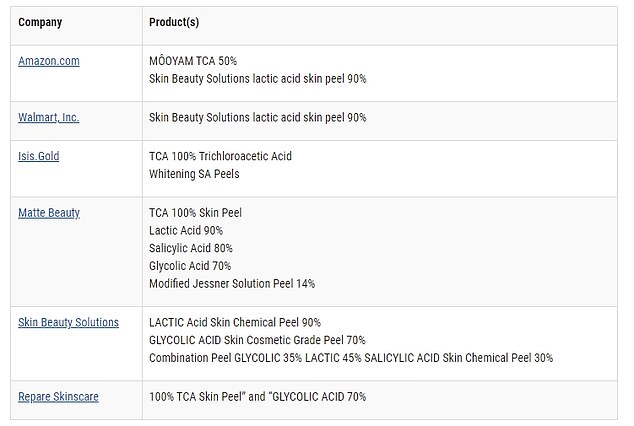Authorities are warning women that some home facial treatments can cause “serious chemical burns” and “disfiguring scars.”
Last week, the FDA issued a warning to consumers not to use at-home chemical peels without the supervision of a dermatologist or risk “serious skin injury.”
The agency’s letter said: “The (FDA) has not approved any chemical peel products, and consumers should only consider using chemical peel products under the supervision of a dermatologist or other licensed and trained practitioner.”
Chemical peels can resurface your face by removing the top layers of skin, increasing collagen and decreasing wrinkles, resulting in a more youthful appearance of the face and neck.
When used under the supervision of a dermatologist, chemical peels can be safe and effective.

The FDA letter included 13 specific chemical peel products from six different retailers.
The treatments help remove the top layers of skin and are touted as solutions for acne, scars and discoloration.
However, these chemicals are potent and if not used properly, they can eat away at too many layers of skin, causing chemical burns, pain, swelling, infection and changes in skin color.
The FDA listed 13 products from six different companies and issued warning letters to each of those companies.
It’s unclear what prompted the FDA to issue the warning, but the agency said none of these products have been approved for home treatment.
In response, several of those products appear to have been removed from some retailer websites.
Products include those from Amazon and Walmart, and smaller companies like Isis.Gold, Matte Beauty, Skin Beauty Solutions and RePare Skincare.
The letter specifies that these products are safe for professionals to use, but clients who use them at home risk damaging their skin.
The cheapest version costs around $13 and the most expensive version costs around $99, depending on the retailer, the chemicals used, and the package size.
For a mild chemical peel, a dermatologist can charge between $100 and $300, a CareCredit Reporta healthcare financial services company, founded.
But for a more intense procedure, which uses more concentrated chemicals and has greater risk, the average cost is around $1,800, according to the American Society of Plastic Surgeons.
A chemical peel is a gel-like solution applied to the face that contains an acidic chemical that eats away at the top layers of old skin to reveal newer, fresher layers underneath.
Some common chemicals used in peels include lactic acid, salicylic acid, and glycolic acid.
The skin has three main sections, each containing many compressed layers of skin cells. These make up the skin and house its imperfections, including scars, acne and discoloration.

In the popular television series Sex and the City, the character Samantha Jones deals with the unpleasant consequences of a chemical peel gone wrong.
Depending on the intensity of the treatment, chemical peels may either peel off the first section of skin, called the epidermis, or penetrate deeper into the second section, called the dermis.
A doctor may recommend different types of peels depending on your goals.
Mild chemical peels can be used to treat fine lines, acne, and dryness, and can be used under professional supervision on a semi-regular basis, depending on the patient’s needs. The Cleveland Clinic.
Deeper, more intense chemical peels produce the most dramatic results and can be used to remove precancerous growths, deep wrinkles, blotchy skin, or acne scars.
These are done sparingly and sometimes under light sedation.
After determining what you want to achieve from a chemical peel, a doctor can apply the solution to your face using a brush, cotton applicator, or gauze.
The solution eats away and damages the top layers of the skin, which then peel off, exposing the newer layers underneath.
However, if the solution is left on the skin for too long, the type of chemical used is too harsh for your needs, or the product is applied too frequently, it can eat away at the more delicate parts of the skin and cause “disfiguring scars.”
Treatments may also cause pain, swelling, infection, and changes in skin color.
In extreme cases, they may require surgery or emergency medical attention, the letter said.

